                  
|

NEWSLETTER - November 2017 |
|
|
|
|
|
|
The antiquity of Hampi can be traced to the Treta
Yuga, the second of the four yugas or eons of Indian chronology.
In the Ramayana, an Indian epic narrating the deeds and adventures
of Rama, Hampi and its surrounding areas are identified with the
kingdom of Kishkindha. This region was the realm of the Vanara
(mythological half-man, half-monkey) brothers Vali and Sugriva and
the birthplace of Hanuman, all of whom played a prominent role in
the epic.
Travel back in time to the glorious days of the 14th century
Vijayanagara Empire. Let the stone monuments at Hampi tell you the
story of what was once described as “the best provided city in the
world”.
This month we bring to you Hampi, Karnataka , as the
destination of the month!
Look forward to receiving your views and feedback on our
efforts to update you with the latest from India.
GITA - India Unveiled! |
|
|
|
Golden Sarovar Portico opens in Amritsar
Sarovar Hotels announced the opening of Golden Sarovar Portico
Amritsar. Situated in the hub of the city and just 10 minutes away
from the Golden Temple, Golden Sarovar Portico, Amritsar is set to
offer the best of services and facilities. Accommodation
facilities categorised into Superior Rooms, Executive Rooms,
Deluxe Suites and Presidential Suite ensure guests a delightful
stay. Featuring elegant rooms with all modern amenities, the hotel
is suitable for business travellers as well as tourists and
pilgrims who travel to the city for visiting Golden Temple and
Jallianwala Bagh. Golden Sarovar Portico, Amritsar offers all
modern facilities including restaurant, bar, banquet hall, meeting
room, fitness room and other amenities at par with international
standards.
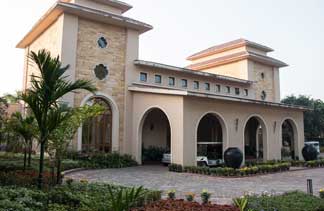 Ibiza
The Fern Resort & Spa opens in Kolkata Ibiza
The Fern Resort & Spa opens in Kolkata
Concept Hospitality has opened a 110-key property in Kolkata
called The Fern Hotels & Resorts. Spread across 20 acres of
landscape, the resort offers a host of activities such as rock
climbing, rappelling, shooting and paddling. It offers rooms in
five different categories. The property also has one of the
largest banqueting facilities both indoors as well as outdoors.
The indoor space is spread over 5,000 sq ft and is ideal for big
conferences and cocktail dinners.
WelcomHeritage adds new property in Amritsar
WelcomHeritage has launched its first farm-stay property,
Ranjitvilas in Amritsar. The property has been developed and
approved by the Punjab Heritage & Tourism Promotion Board under
its Farm Tourism Scheme. Sunil Gupta, CEO, WelcomHeritage shared,
“Ranjitvilas is a boutique property and true reflection of Indian
hospitality and inheritance. bringing the perfect amalgamation of
rustic feel of India with Indian hospitality values and rich
heritage of the country.” The property features 20 exquisitely
designed executive rooms each with a personal courtyard and two
suite rooms. All rooms and suites are equipped with mini bar, LED
television, temperature control, satellite channels, in-room tea
and coffee maker, safe box and Wi-Fi broadband connectivity. The
farmhouse boasts of handcrafted furnishings inspired by the
traditions of Indian culture.
Westin debuts in Kolkata with 314-key hotel
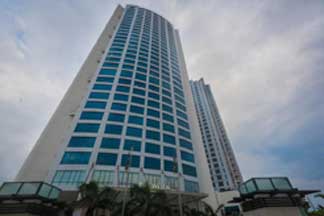 Westin
Hotels & Resorts, part of Marriott International, opened The
Westin Kolkata Rajarhat, its eighth hotel in India. The property,
featuring 314 guestrooms and suites, is located eight kilometres
away from Netaji Subhas Chandra Bose International Airport. Westin
Hotels & Resorts, part of Marriott International, opened The
Westin Kolkata Rajarhat, its eighth hotel in India. The property,
featuring 314 guestrooms and suites, is located eight kilometres
away from Netaji Subhas Chandra Bose International Airport.
The hotel features over 50,000 sq ft of flexible function spaces,
ideal for meeting, conferences, corporate events and weddings.
From large-scale events in the ballroom to smaller gatherings in
one of the function rooms with state-of-the-art facilities, the
professional conference and banquet team will make sure every
detail is taken care of. The hotel boasts of a helipad to provide
easy VIP accessibility.
218-room Indore Marriott Hotel opens doors
Marriott International has added another property to its portfolio
in Indore with the opening of the 218-room Indore Marriott Hotel.
Facilities at the hotel include recreational facilities such as
the renowned Quan Spa with 5600 sqft of space offering a blend of
modern and traditional therapies. The hotel also boasts of an
outdoor swimming pool and a fully equipped, state-of-the-art
fitness centre. Indore Marriott Hotel is the largest in the state
in terms of rooms and meeting space – which covers 55,000 sqft of
meeting and banqueting space. The property is located a few
minutes away from the airport.
 342-room
Novotel & Ibis OMR Chennai opens doors 342-room
Novotel & Ibis OMR Chennai opens doors
AccorHotels has announced the opening of the Novotel and Ibis OMR
Chennai. Being termed as the first combo property in Chennai, the
hotel has the advantage of being strategically located in the
centre of the IT Expressway (OMR). The 342 (combined) rooms
property is AccorHotels first joint development in the city.
Featuring midscale and economy brand under the same complex, the
153- room Novotel and 189-room Ibis Chennai OMR offers travellers
a choice of offerings across different price points.
|
|
|
67.3% growth in foreign arrivals on
eTV in Oct ’17 y-o-y
During the month of October, 2017, a total of 1.76 lakh foreign
tourists arrived on e-Tourist Visa as compared to 1.05 lakh during
the month of October, 2016 registering a growth of 67.3 per cent.
During January- October 2017, a total of 12.43 lakh foreign
tourists arrived on e-Tourist Visa as compared to 7.81 lakh during
January- October 2016, registering a growth of 59.2 per cent. The
percentage share of top 15 source countries availing e- Tourist
Visa facilities during October, 2017 was as follows: UK (18.2%),
USA (9.7%), France (6.3%), Germany (6.0%), Australia (4.3%),
Russian Federation (4.1%), Canada (3.9%), Thailand (3.7%), China
(3.7%), Korea (Rep.of) (2.6%), Spain (2.3%), Oman (2.2%), Italy
(2.2%), Netherlands (1.9%) and Malaysia (1.6%). The percentage
share of top 15 ports in foreign tourist arrivals on e-Tourist
Visa during October 2017 was as follows: New Delhi Airport
(53.0%), Mumbai Airport (16.6%), Bengaluru Airport (5.5%), Chennai
Airport (5.3%), Dabolim (Goa) Airport (4.5%), Kochi Airport
(3.5%), Kolkata Airport (2.5%), Hyderabad Airport (2.4%), Amritsar
Airport (2.0%), Trivandrum Airport (1.1%), Ahmadabad Airport
(1.0%), Jaipur Airport (0.7%), Gaya Airport (0.6%), Calicut
Airport (0.4%) and Tirchy Airport (0.4%).
|
|
|
GoAir adds 30 flights, increases frequencies
GoAir has announced new additional flights for the winter
schedule, effective from November 23, 2017. The airline will
operate 22 of these flights on new routes apart from increasing
the frequencies by eight flights on existing routes during
winters. With the new additions, GoAir would operate an average of
240 flights a day, strengthening its market presence at Ahmedabad,
Bengaluru, Chennai, Delhi, Hyderabad, Kochi, Kolktata, Lucknow,
Nagpur and Patna. It has also announced its first daily flight
between Jammu and Leh.
 Air
Canada’s Delhi-Vancouver flight to go daily from Dec 1 Air
Canada’s Delhi-Vancouver flight to go daily from Dec 1
Air Canada has been on an expansion spree in India. The airline
will make its Delhi-Vancouver-Delhi flight a daily service from
December 1. It’s four times a week currently and will go daily
from December 1, 2017.
Brussels Airlines increases
flight frequency to Mumbai
After opening a direct flight connection between Brussels and
Mumbai last March, Brussels Airlines has welcomed over 60,000
travelers on its flights. The airline now increases its flight
offer from 5 to 6 weekly flights during the winter season,
offering more flexibility and choice. This week, Brussels Airlines
participates to the Belgian Royal State Visit to India and
partners up with other Belgian organizations to organise a dance
event at the Gateway of India. On March 30, Brussels Airlines
inaugurated its direct flights between Mumbai’s Chhatrapati
Shivaji airport and Brussels Aiport and has since seen its results
on the route growing more and more. After a positive 7-month
period with an average seat load factor of almost 80%, the airline
has decided to invest even more in the route, by adding an extra
flight on Saturday, bringing the total to 6 flights per week and
additional flight frequency.
 KLM’s
Mumbai-Amsterdam resumes service after 16 years KLM’s
Mumbai-Amsterdam resumes service after 16 years
In a move to enhance air connectivity, Chhatrapati Shivaji
International Airport (CSIA) welcomed Dutch Carrier, KLM’s Mumbai
and Amsterdam services on October 30. The airline will be
operating 294-seater Boeing 787-9 aircraft with 30 World Business
Class, 45 Economy Comfort Class And 219 Economy Class. The flights
will operate thrice a week. Earlier, Mumbai-Amsterdam route was
served with daily services offered by Jet Airways. Along with KLM,
the route will be served with a total of ten services per week.
Finnair to open new route to Goa from Nov 1
Finnair is poised to enter the largest expansion in its history
during the upcoming winter season with new routes opening to 20
intercontinental destinations including India, Mexico, Cuba,
Dominican Republic and Lapland. Finnair is opening new routes to
Goa from November 1, 2017; to Puerto Vallarta, Mexico on November
5; to Puerto Plata, Dominican Republic on November 30 and to
Havana, Cuba on December 1.
 Jet
starts third non-stop daily between Mumbai-London Jet
starts third non-stop daily between Mumbai-London
Jet Airways is all set to commence its third daily non-stop
service between Mumbai and London Heathrow with effect from the
forthcoming weekend. This makes Jet the only Indian airline to
operate thrice daily services between Mumbai and London Heathrow –
one of the world’s busiest airports. The latest frequency to
London Heathrow – 9W 116, will depart on Sunday, October 29, 2017,
from Mumbai on board Jet Airways’ Boeing 777-300 ER. The addition
of the third flight from Mumbai to London Heathrow complements the
airline’s existing operations to the English capital from its hubs
in Mumbai and Delhi, aboard its flagship B777-300 ER aircraft.
|
|
Hampi
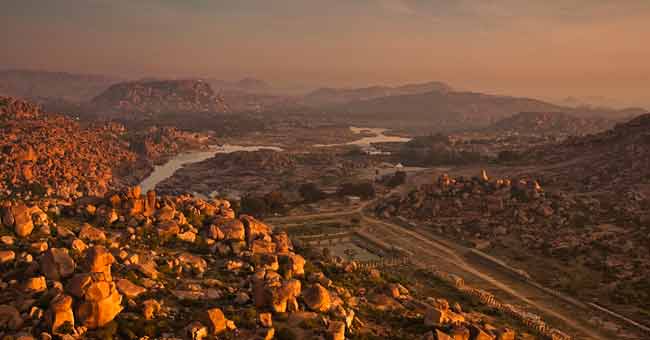
Myths & Legends from the Ramayana
After the abduction of Sita by Ravana, Rama and his brother
Lakshmana arrive in Kishkindha in search of Sita. During their
wanderings they meet up with Hanuman at Rishimukha hill. Hanuman
explains to them the state of affairs in the kingdom stressing
upon the rivalry between King Vali and his estranged brother
Sugriva. Rama expresses a desire to meet with Sugriva to hear his
side of the story. Hanuman accordingly arranges a meeting between
them.
During the course of their conversation, Sugriva informs Rama that
he had seen Ravana transport Sita through the air in the Pushpaka
Vimana. He also shows Rama some Jewellery that Sita had dropped
during the flight, which he had found and hidden away. On seeing
the jewels, Rama confirmed that it was indeed Sita’s, and decided
to help Sugriva overthrow his brother Vali in exchange for his
support in rescuing Sita.
Legends
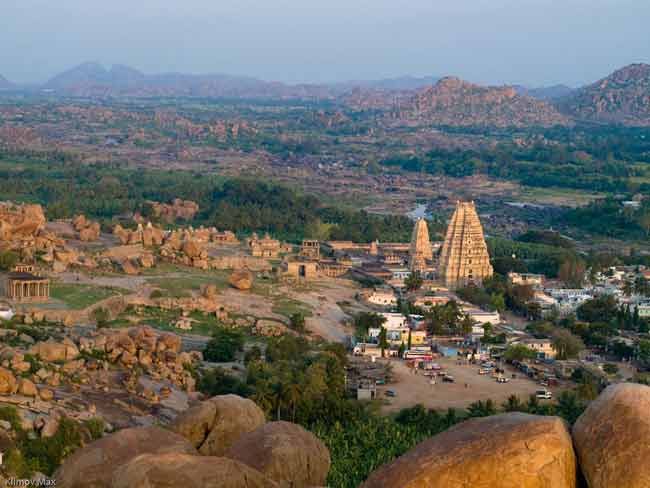 Pampa
to Hampi… Pampa
to Hampi…
Goddess Pampa, daughter of Lord Brahma, was once performing
penance on top of the Hemakuta Hill. Kamadeva – the God of love,
observed her and Lord Shiva who was in meditation nearby and
schemed to bring both of them together. Shiva was furious at being
disturbed and opened his third eye in wrath, reducing Kama to
ashes. However, Kama’s ploy worked. Shiva, pleased with Pampa’s
devotion, eventually marries her. From this time on, Pampa came to
be identified with Parvati, Shiva’s consort, while Lord Shiva
himself began to be called Pampapati or Pampa’s lord. Hampi, a
derivation from goddess Pampa, was also known as Pampakshetra.
Hare and the Hound!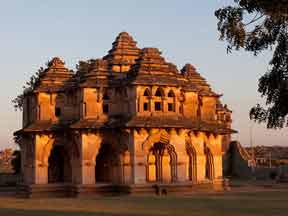
Local legend has it that Harihara I and Bukka I, two local
chieftains from the Anegundi region were on a hunting expedition
in the nearby hills. They sighted a large hare and set their
hunting dogs on the animal. However, the hare picked up its
courage and turned around and started chasing the hunting dogs. On
their return, they reported this incident to their guru,
Vidyaranya, who went back with them to the place of the incident.
The guru informed them that the place was sacred, and advised them
to establish the capital of their new kingdom there. The seed of
an empire was sown. Over the next 200 plus years (1336 AD – 1565
AD), Hampi was the capital for the four dynasties that ruled the
Vijayanagara Empire.
History
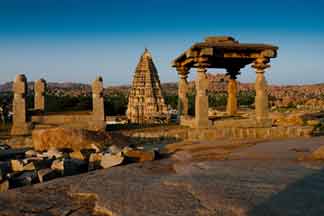 The
discovery of stone artefacts, pottery shards and rock paintings
indicate that Hampi has been inhabited since pre-historic times. The
discovery of stone artefacts, pottery shards and rock paintings
indicate that Hampi has been inhabited since pre-historic times.
The Hampi region’s historical antiquity can be pushed back to the
Mauryan period (322BCE – 182 BCE) as evidenced by the rocks edicts
of King Asoka discovered in the area. The presence of inscribed
Buddhist panels, comparable to that of the Amravati School
belonging to the 1st and 2nd centuries CE from the time of the
Satavahanas (271 BCE- 220CE), give us some more definitive clues
of its pre Vijaynagara history.
Many dynasties ruled over this region, the most prominent among
them being the Chalukyas of Badami (5 – 6 th century), the
Rashtrakutas of Manyakheta (7 – 8 th century), the Chalukyas of
Kalyana (9 – 11 th century), the Hoysalas of Belur and Halebidu
(11 – 13 th century) and the Yadavas of Devagiri (13 th century).
Towards the late 13th century and the beginning of the 14th
century, the area was invaded by the Delhi Sultanate who were,
however, unable to retain the area for long. This led to a ‘power
vacuum’ into which slipped two brothers – Harihara I and Bukka I –
who seeded the Vijayanagara Empire that ruled the area with Hampi
as its capital.
Three major dynasties ruled over the Vijayanagara Empire: Sangama
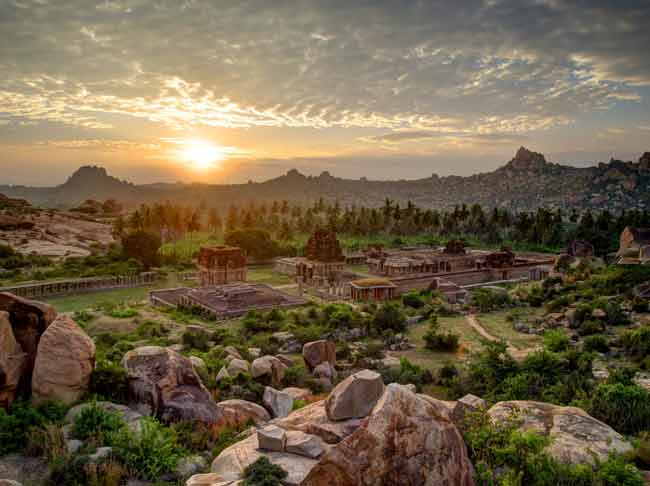 (1336
– 1485), Saluva (1485 – 1505) and Tuluva (1505 – 1570). (1336
– 1485), Saluva (1485 – 1505) and Tuluva (1505 – 1570).
The most famous kings of this vast empire were Devaraya II and
Krishna Devaraya of the Tuluva dynasty. The reign of Krishna
Devaraya is known as the golden period of the Vijaynagara Empire
and is chronicled in great detail.
Domingo Paes, a Portuguese horse trader, who visited Hampi during
its prime wrote “The size of this city I do not write here,
because it cannot all be seen from any one spot, but I climbed a
hill whence I could see a great part of it. I could not see it all
because it lies between several ranges of hills. What I saw from
thence seemed to me as large as Rome, and very beautiful to the
sight; there are many groves of trees within it, in the gardens of
the houses, and many conduits of water which flow into the midst
of it, and in places there are lakes and the king has close to his
palace a palm-grove and other rich fruit-bearing trees. Below the
Moorish quarter is a little river, and on this side are many
orchards and gardens with many fruit-trees, for the most part
mangoes and areca-palms and jack-trees, and also many lime and
orange trees, growing so closely one to another that it appears
like a thick forest; and there are also white grapes. All the
water which is in the city comes from the two tanks of which I
have spoken, outside the first enclosing wall.”
Geography
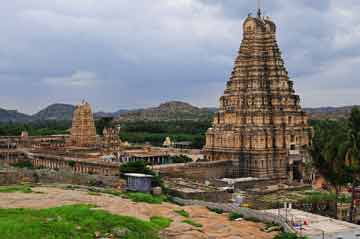 The
landscape in & around Hampi falls under Eastern Dharwar craton
which is believed to be 3.4 to 2.0 billion years old and
highlights the major early pre Cambrian events in the craton. It
consists of granite & greenstone terrain – One of the oldest
exposed surfaces on earth. The
landscape in & around Hampi falls under Eastern Dharwar craton
which is believed to be 3.4 to 2.0 billion years old and
highlights the major early pre Cambrian events in the craton. It
consists of granite & greenstone terrain – One of the oldest
exposed surfaces on earth.
Due to continuous erosion, at first underground, and later by
exposure to sun, wind & rain, the surface of the monoliths
cracked, split and eventually weathered into spherical shapes
creating rounded and detached boulders, some perched in precarious
positions giving the impression that they are about to roll over
while some have devolved into random shapes and forms of
sculptural merit!
Flora & Fauna
The district is characterized by dry deciduous scrub and southern
thorn forests. Apart from them other animals found in these areas
include leopards, wild boars, jackals, hyenas, porcupines, star
tortoises, pangolins, mongooses and monitor lizards.
There are around 230 species of birds recorded in the area with
the Grey Francolin, Barred Buttonquail, Common Kestrel and White –
throated Kingfisher, being among the most commonly sighted ones.
The boulder strewn landscape is crisscrossed by small streams and
irrigation canals where historically mangoes, areca- palms,
jackfruit, lime and orange trees were cultivated. Today one can
find rice fields, banana farms and sugarcane fields here. These
splashes of cultivation add to the surreal feel of the landscape.
The Sloth bear (Melursus ursinus) is a nocturnal insectivorous
bear species found in the Indian Subcontinent. Sloth bears feed on
termites, relying on their sense of smell to locate prey. They use
their sickle-shaped claws to reach the termites and suck them up
through their muzzle. They have a distinctive white colored
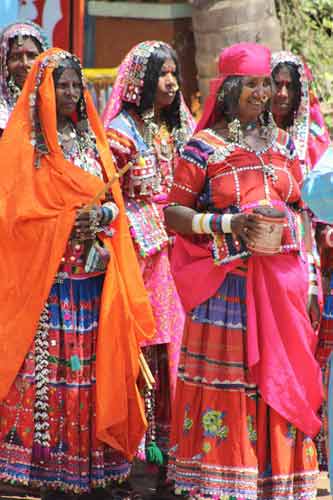 V
shaped mark on their chest that contrasts with their black fur.
Hampi’s surroundings is prime habitat for the Sloth Bear. V
shaped mark on their chest that contrasts with their black fur.
Hampi’s surroundings is prime habitat for the Sloth Bear.
People
Hampi is a world heritage site and not a living city anymore. The
towns close to it are Hospete, Kamalapura, Anegundi and Ballari –
which is also the district Hampi is in. Many communities living
here have had historical ties with the region while many have
arrived here over time in search of livelihoods.
Gypsy Queens
Hampi region is also home to the Lambanis, a gypsy tribe, now
living in settlements called Tandas. Said to hail from Rajasthan,
the Lambani women are indeed a colourful lot. Their intricately
designed and crafted dresses with an emphasis on mirror-work are
created for them by specialist tailors. Decked up and decorated
with heavy anklets, large nose-rings, braided hair, colourful
necklaces and trademark jewelry, they stand out in Hampi’s rugged
landscape. Adding to this, the tattoos on their arms, ankles,
legs, and interestingly on their foreheads, are created using
traditional tools on reaching marriageable age.
|
|
                  
|
|





































